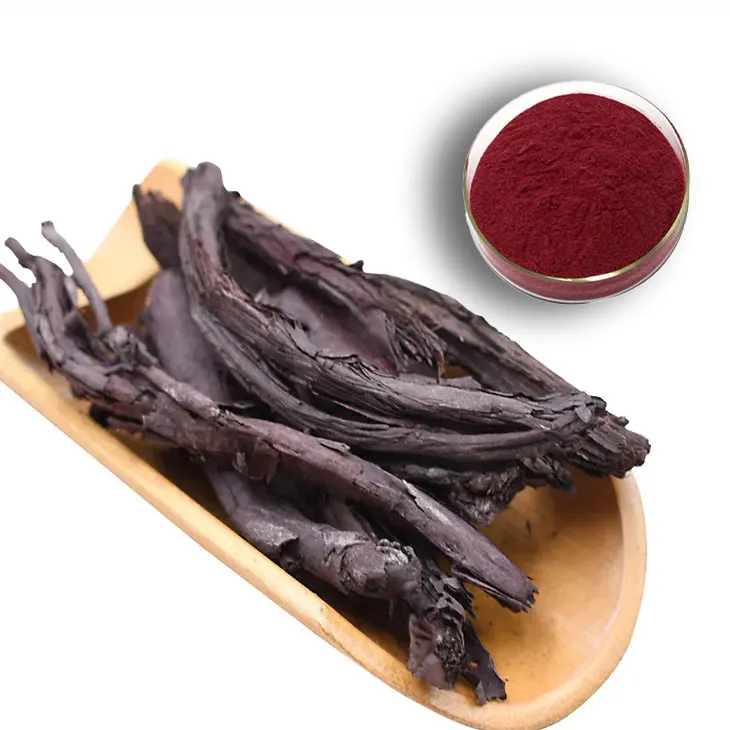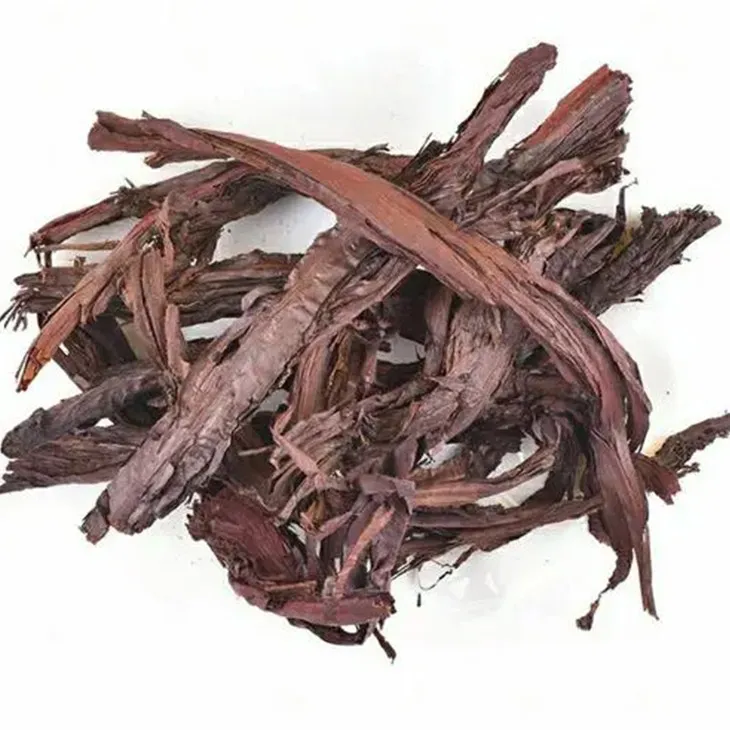- 0086-571-85302990
- sales@greenskybio.com
Chinese Shikonin Factories.
2024-11-29

1. Introduction to Shikonin
Shikonin, a reddish - purple compound, has long been recognized in traditional Chinese medicine for its anti - inflammatory, antimicrobial, and wound - healing properties. It is a valuable natural product that has attracted significant attention from the pharmaceutical and cosmetic industries around the world. China, with its rich traditional medicine heritage, has become a major player in the production of Shikonin.

2. China's Advantage: Rich Biodiversity
China's natural habitats provide a stable source of raw materials for shikonin production. The country is blessed with a wide variety of plant species, some of which are rich sources of shikonin. These natural resources are a crucial foundation for the development of shikonin factories in China.
2.1 Sustainable Harvesting Practices
However, sustainable harvesting practices are also emphasized. The shikonin factories in China work closely with local farmers and conservationists. They ensure that the plants used for shikonin extraction are not over - harvested. This is essential to maintain the long - term availability of raw materials. Moreover, it is crucial for the well - being of the ecosystems where these plants grow. For example, some plants may be harvested on a rotational basis, allowing sufficient time for regeneration.

3. Production Process: Combining Tradition and Modernity
In the production process, the factories combine traditional knowledge with modern technology. Traditional extraction methods passed down through generations are refined and integrated with state - of - the - art manufacturing processes.
3.1 Examples of Combined Extraction Methods
For instance, ultrasonic - assisted extraction is sometimes used in combination with traditional solvent extraction to increase the extraction rate of shikonin. This combination allows for a more efficient and effective extraction process. Ultrasonic - assisted extraction can break down the cell walls of the plant material more easily, enabling the solvent to access the shikonin more readily. Traditional solvent extraction, on the other hand, has been used for a long time and has its own advantages in terms of selectivity and purity of the extracted product.

4. Economic Contributions
These factories contribute significantly to the economic development of the regions where they are located.
4.1 Employment Opportunities
They create employment opportunities in multiple sectors. Firstly, in the production line itself, a large number of workers are needed for tasks such as plant collection, extraction, purification, and product packaging. Secondly, in related industries such as packaging, transportation, and research. For example, the packaging industry benefits from the demand for proper packaging of shikonin products to ensure their quality during transportation and storage. The transportation industry is involved in shipping the shikonin products to different markets, both domestic and international. In the research field, there is a need for continuous improvement of production processes and exploration of new applications of shikonin, which also creates jobs for scientists and researchers.
4.2 Boosting China's Standing in Global Trade
As China's shikonin factories export their products to international markets, they also enhance China's standing in the global pharmaceutical and cosmetic trade. China is becoming known as a reliable source of high - quality shikonin products. This not only brings in foreign exchange but also promotes international cooperation in the fields of pharmaceuticals and cosmetics. For example, Chinese shikonin factories may collaborate with foreign companies for further product development or marketing, which can lead to mutual benefits and strengthen China's position in the global value chain.
5. Environmental Considerations
On the environmental front, efforts are being made to reduce the environmental impact of shikonin production.
5.1 Adoption of Green Technologies
Factories are increasingly adopting green technologies. One aspect is using renewable energy sources for powering the extraction and purification processes. For example, solar power or wind power can be used to reduce the reliance on traditional fossil fuels, thereby reducing carbon emissions. Another important area is treating and recycling waste water. Waste water generated during the production process contains various substances that can be harmful to the environment if not properly treated. By treating and recycling waste water, the factories can minimize pollution and also save water resources. This is beneficial for both the local environment and the long - term sustainability of the shikonin production industry.
6. Quality Control and Standardization
Quality control and standardization are crucial aspects of shikonin production in Chinese factories.
6.1 Importance of Quality Control
Quality control ensures that the shikonin products meet the required standards for safety and efficacy. This is especially important for products used in the pharmaceutical and cosmetic industries. For example, in the pharmaceutical industry, shikonin - based drugs need to have consistent quality to ensure their therapeutic effects. In the cosmetic industry, shikonin - containing products need to be of high quality to meet consumer expectations for skin - friendly and effective products.
6.2 Standardization Efforts
Chinese shikonin factories are actively involved in standardization efforts. They work with relevant regulatory bodies and industry associations to establish standards for shikonin production. These standards cover aspects such as raw material quality, production processes, and product quality specifications. Standardization helps to ensure the uniformity and reliability of shikonin products, which is beneficial for both domestic and international markets. It also facilitates trade by providing a common set of criteria that both producers and consumers can rely on.
7. Research and Development in Shikonin - Based Products
Research and development (R & D) play a vital role in the future of shikonin - based products in Chinese factories.
7.1 New Applications in Pharmaceuticals
There is ongoing research to explore new applications of shikonin in the pharmaceutical industry. For example, scientists are investigating its potential in treating more complex diseases such as certain types of cancer or autoimmune disorders. Shikonin's anti - inflammatory and antimicrobial properties may offer new therapeutic approaches for these diseases. By conducting in - vitro and in - vivo studies, researchers hope to unlock the full potential of shikonin in the medical field.
7.2 Innovations in Cosmetic Formulations
In the cosmetic industry, R & D efforts are focused on creating innovative formulations with shikonin. For instance, shikonin can be incorporated into creams, lotions, or serums to enhance skin health. It may be used for anti - aging purposes, as it can help reduce inflammation and promote skin cell regeneration. Additionally, research is being done to improve the stability and bioavailability of shikonin in cosmetic products, ensuring that it can effectively deliver its beneficial properties to the skin.
8. Challenges and Solutions
Despite the many advantages and positive aspects of shikonin factories in China, there are also some challenges that need to be addressed.
8.1 Competition from Synthetic Alternatives
One challenge is the competition from synthetic alternatives. Synthetic compounds that mimic the properties of shikonin may be cheaper to produce in some cases. However, natural shikonin has its unique advantages, such as its complex chemical composition and potential for fewer side effects. To overcome this challenge, Chinese shikonin factories need to focus on highlighting the natural and high - quality aspects of their products. They can also invest in research to further understand and promote the unique benefits of shikonin compared to synthetic alternatives.
8.2 Regulatory Compliance
Another challenge is regulatory compliance. As shikonin - based products are exported to different countries, they need to meet the regulatory requirements of various international markets. This includes aspects such as product safety, labeling, and environmental regulations. Chinese factories need to stay updated with the latest regulations and ensure that their production processes and products are in compliance. They can work closely with regulatory consultants and international partners to navigate the complex regulatory environment.
9. Conclusion
In conclusion, Chinese shikonin factories are making significant contributions to the pharmaceutical and cosmetic industries. They benefit from China's rich biodiversity, combine traditional and modern production methods, contribute to economic development, and are increasingly aware of environmental protection. Although there are challenges, such as competition from synthetic alternatives and regulatory compliance, there are also solutions available. With continued research and development, quality control, and international cooperation, Chinese shikonin factories are likely to play an even more important role in the global market in the future.
FAQ:
What are the main properties of shikonin?
Shikonin is a reddish - purple compound that has anti - inflammatory, antimicrobial, and wound - healing properties.
How do shikonin factories in China ensure a stable supply of raw materials?
China's shikonin factories benefit from the country's rich biodiversity. They work closely with local farmers and conservationists to ensure sustainable harvesting, preventing over - harvesting of the plants used for shikonin extraction and maintaining the ecosystems.
What role does modern technology play in shikonin production in China?
In the production process, Chinese shikonin factories combine traditional knowledge with modern technology. For example, traditional extraction methods are refined and integrated with modern manufacturing processes like ultrasonic - assisted extraction which may be used in combination with traditional solvent extraction to increase the extraction rate of shikonin.
How do shikonin factories contribute to the local economy?
These factories contribute to the economic development of their regions. They create employment opportunities not only in the production line but also in related industries such as packaging, transportation, and research. Their exports also enhance China's standing in the global pharmaceutical and cosmetic trade.
What are the environmental efforts made by shikonin factories?
On the environmental front, shikonin factories in China are making efforts to reduce the environmental impact of production. They are increasingly adopting green technologies, such as using renewable energy sources for extraction and purification processes and treating and recycling waste water to minimize pollution.
Related literature
- Shikonin: Properties, Production and Applications"
- "The Role of Chinese Shikonin Factories in the Global Market"
- "Sustainable Shikonin Production in China"
- ▶ Hesperidin
- ▶ Citrus Bioflavonoids
- ▶ Plant Extract
- ▶ lycopene
- ▶ Diosmin
- ▶ Grape seed extract
- ▶ Sea buckthorn Juice Powder
- ▶ Fruit Juice Powder
- ▶ Hops Extract
- ▶ Artichoke Extract
- ▶ Mushroom extract
- ▶ Astaxanthin
- ▶ Green Tea Extract
- ▶ Curcumin
- ▶ Horse Chestnut Extract
- ▶ Other Product
- ▶ Boswellia Serrata Extract
- ▶ Resveratrol
- ▶ Marigold Extract
- ▶ Grape Leaf Extract
- ▶ New Product
- ▶ Aminolevulinic acid
- ▶ Cranberry Extract
- ▶ Red Yeast Rice
- ▶ Red Wine Extract
-
Green Tea Extract
2024-11-29
-
Plantain extract
2024-11-29
-
Sea buckthorn Juice Powder
2024-11-29
-
Echinacea Extract
2024-11-29
-
Red Wine Extract
2024-11-29
-
Kelp Extract Powder
2024-11-29
-
Kidney Bean Extract
2024-11-29
-
Genistein
2024-11-29
-
Reishi mushroom extract
2024-11-29
-
Artichoke Leaf Extract
2024-11-29





















